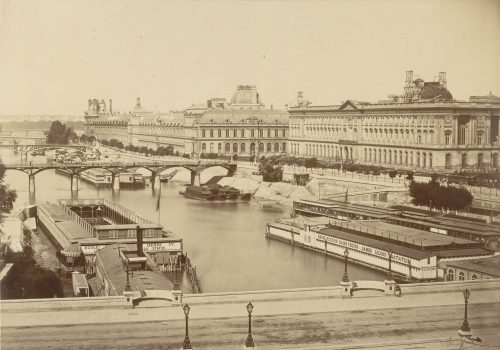The castle exhibits the collection of photographs of the Duke of Aumale. Louis Philippe’s son bequeathed no less than 1,400 photographs taken around the 1860s.
At the time, photography was in its infancy. It is given to the world in 1839 by the scientist François Arago who promotes it after the first experiments of Louis Daguerre in presenting the first pictures at the Academy of Sciences and the Academy of Fine Arts. The Duke of Aumale, for his part, had been exiled to England since the revolution of 1848 which had chased his father from the throne of France. Rival of Napoleon III, heir to a huge fortune, he became an inveterate collector, and, on the advice of his friend the Viscount Joseph Vigier, himself a photographer, he started collecting the first photographs. The exhibition at Château de Chantilly is spread over five rooms, all dedicated to a theme and well curated, we understand the motivations of the son of Louis Philippe. Photography was for him a way of looking at the world in a particular situation, where, in exile from his motherland he had to come to terms with a host country, far from his friends and his ways.
Baldus
Thus, the exhibition opens with views of Paris in the 1860s. The Bisson brothers and Edouard Denis Baldus immortalize the changes that occurred in the capital at the time of the advent of Napoleon III. They photographed the architecture, the Palais des Tuileries, childhood residence of the Duke of Aumale and which was not yet destroyed – it will be destroyed during the Commune in 1871 as well as the town hall which is also presented in a photograph. However, there are already changes that the Duke d’Aumale was curious to see: the development of the boulevards under the leadership of Haussmann, including next to the tower of Saint-Jacques, the boulevard de Strasbourg, taken in photography by Baldus in 1858. One can easily imagine the duke surprised by the transformations of a city that has turned his back on him and of which he still feels enamored, while still freshly settled in a wealthy part of London.
Alger
But photography is also the gateway to an elsewhere. The Duke of Aumale often goes to Italy. His mother is a Neapolitan princess and his parents were married in Palermo. He has land in the country and he goes there frequently. He naturally collects pictures of Rome views today attributed to anonymous photographers. The excavations of the Forum in the center of the city, the castle St. Angelo bordering the Vatican – where the popes could take refuge in case of attack. A sight from Athens around 1860 is striking: the Acropolis is still surrounded by fields, as if had never been the city we know and give, the feeling of an imaginary castle standing on the horizon, vaporous, like the smoke of a dream. Beside, are exhibited photographs of Algiers. The Duke of Aumale knew the city well for being governor of Algeria at the age of 25. Naturally he possessed images of the country, including Oriental women lying with a hookah at their feet; photographs offered by his brother, the Admiral Joinville.
The cold, the frost
Another trip: the trips to the alpine mountains. At that time, fashion was for the pure mountain air and in particular the fact of returning with a picture of the place where one had gone. The Duke of Aumale collected the images of Adolphe Braun. This industrial designer who discovered photography using it to accompany the drawing on fabric and who developed the art art of shooting in the mountains and make elegant paintings where the eyes can be lost on the horizon of snow-capped mountains, or the beauty of a frozen lake. We must imagine the difficulty represented of taking these photographs then: it was necessary to fight against the cold, the frost. As a reward, these images were presented at major international exhibitions and they helped to raise the profile of photography as art.
Leviathan
This documentary role of photography was also developed for architecture and objects Art. The Duke of Aumale also possessed images of the ruins of the Abbey of Vaux-de- Cernay, beautiful melancholic pictures where wild herbs fight over the remains of stones. These photographs were offered by the Baroness Rothschild, who owned the property. Other documents: the snapshots of Louis Rémy Robert, who took photographs of ceramics made at the Manufacture de Sèvres or those of the photoreporter Robert Howlett who is interested, in November 1857, in the construction of a huge ship in London, the Leviathan. Of course, the Duke also had a myriad of portraits in his collection. The exhibition presents them in a small window before going to the last room where are hung the seascapes of Gustave Le Gray. Failed painter, Gray will make a fortune in photography before going bankrupt and facing a difficult life. he invented “marine” (seascape) in photography, and gave us a picture that will make him famous: “Brig in the moonlight.” A sailboat on the horizon while the sun spreads over the back of the sea, while thick clouds accompany the purity of the sky, while onlookers pick up something on the beach … Mysterious and deep image.
Jean-Baptiste Gauvin
















